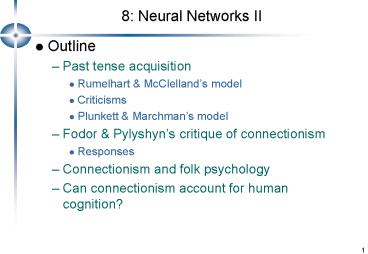8: Neural Networks II - PowerPoint PPT Presentation
1 / 18
Title:
8: Neural Networks II
Description:
Fodor & Pylyshyn's critique of connectionism. Responses. Connectionism and folk psychology ... Come comed, camed. Eat eated. 8. Implications ... – PowerPoint PPT presentation
Number of Views:92
Avg rating:3.0/5.0
Title: 8: Neural Networks II
1
8 Neural Networks II
- Outline
- Past tense acquisition
- Rumelhart McClellands model
- Criticisms
- Plunkett Marchmans model
- Fodor Pylyshyns critique of connectionism
- Responses
- Connectionism and folk psychology
- Can connectionism account for human cognition?
2
How do we learn language?
- Chomskyan view
- Innate knowledge of possible rules of language
- Children create hypotheses about how these rules
apply to the language they are learning - We have mental representations of these rules
- Alternate view
- No explicit representation of rules, although
performance can be described in terms of rules
3
Past-tense acquisition (Brown, 1973)
- 1) specific forms learnt both regular and
irregular - 2) overgeneralisation of irregular verbs
- e.g. wented, goed, eated
- 3) correct pronunciation of both regular and
irregular verbs
Correct production
time
4
Rumelhart McClellands (1986) Model
5
Rumelhart McClellands (1986) Model
- Architecture
- Single layer pattern associator
- Inputs present tense (460 units)
- Outputs past tense (460 units)
- Words represented as sets of Wickelfeatures
- Extra networks at back front of pattern
associator to encode/decode Wickelfeatures from
phonological representation
6
Rumelhart McClellands (1986) Model
- Word representation
- Phonological form /kAm/ came
- But, indistinguishable from /mAk/ or /Akm/
- Wickelphones
- Context sensitive kA, kAm, Am
- Can be analysed along 4 dimensions
- e.g. /A/ long, low, vowel, front
- Wickelfeatures
7
Training Results
- Training sets
- 10 high frequency words (8 irregular)
- 410 medium frequency words (76 irregular)
- 86 low frequency words (14 irregular)
- Trained on high frequency only then medium
frequency added low frequency used later - Results
- U-shaped curve
- Overgeneralisation
- Come ? comed, camed
- Eat ? eated
8
Implications
- Links between regular verb stems and past tense
forms can be described using rules, but is
governed by a mechanism which does not use
explicit rules - Knowledge of past-formation is distributed across
the network - Links between irregular verb stems and past tense
forms are encoded in same set of weights - In a rule-based account, there would need to be a
rule for producing regular verbs and a list of
exceptions (irregulars)
9
Pinker Prince (1988)
- The U-shaped curve is a result of the way in
which the input was presented, not anything to do
with the properties of the network - The middle of the curve coincides with the
addition of the medium frequency verbs - Network is flooded by regular verbs forces
network to generalise - In real language input, there is no such
discontinuity
10
Pinker Prince (1988)
- RM model does a poor job of generalizing to some
novel verbs - mail ? membled
- tour ? toureder
- Model doesnt conceive of stemsuffix
- Cannot encode the formula for creating a
past-tense ending - Task decomposition
- Past tense treated as autonomous
- Wickelphones Wickelfeatures
11
Plunkett Marchmans (1991) Response
- Model of past-tense acquisition using
back-propagation network - 3 layer network, 20 units per layer
- No discontinuity in input
- Didnt use wickelfeatures
- Parametric studies
- 74 of tokens irregular regular not learned
- 74 of tokens regular irregular not learned
- 50/50 (about the same as parental input) network
performed well - No global U-shaped curve
- Micro U-shaped curves corresponds better to
child data as global U-shaped curve is a myth.
12
Fodor Pylyshyns (1988) critique of
connectionism
- Connectionism is inadequate as a representational
system - Symbolic system necessary for modelling cognitive
processes - Connectionist systems lack a combinatorial syntax
and semantics - Productivity
- Systematicity
- Coherence
- Connectionism just provides an implementation of
symbolic processing
13
Response 1 Approximationist approach
- Symbolic models are approximately correct
- cf. Newtonian physics
- Subsymbolic models required for intuitive
processing - Language does not take place at a conscious level
- Cognitive behaviour not rule-governed, can merely
be rule-described
14
Response 2 Externalist approach
- Symbols are human artifacts
- Symbol manipulation is learned
- Initially carried out on symbols in the external
environment - We are confronted with external symbols (e.g.
written language and mathematical notation) - We learn to manipulate them.
- Internalisation of these symbols occurs
15
Connectionism Folk Psychology
- Connectionism provides a conceptual foundation
that might replace folk psychology. - Neural nets show that simple cognitive tasks can
be performed without employing features that
could correspond to beliefs, desires and plans. - Provides support for eliminativism
16
Can connectionism account for human cognition?
- Learning driven by examples
- Knowledge of rules is emergent
- Multitude of of sub-symbolic representations
- Complex interaction produces behaviour which is
rule-like - Knowledge of rules remains implicit
- Cannot analyse own activity
- Cannot form symbolic representations of rules
17
Clark Karmiloff-Smith (1993)
- To model human development adequately,
connectionist systems must be able to - Treat own representations as objects for further
manipulation - Do so independently of continual training input
- Retain copies of original networks
- Form new structured representations
18
Learning Outcomes Reading
- Understand connectionist models of past-tense
acquisition - Understand how rule-like behaviour can emerge
from non-rule-based systems - Be aware of some of the criticisms of the
connectionist approach and the responses to those
criticisms - For next week, read
- Embodied Cognitive Science Basic Concepts from
Pfeifer, R. Scheier, C. (1999). Understanding
intelligence. Cambridge, MA MIT Press. - Further Reading
- See lecture webpage or .pdf handout

